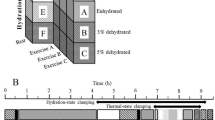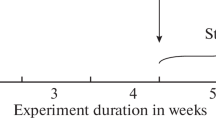Summary
The influence of hyperhydration on thermoregulatory function was tested in 8 male volunteers. The subjects performed cycle exercise in the upright position at 52%V O 2max for 45 min in a thermoneutral (Ta=23° C) environment. The day after the control exercise the subjects were hyperhydrated with tap water (35 ml · kg−1 of body weight) and then performed the same physical exercise as before.
Total body weight loss was lower after hyperhydration (329±85 g) than during the control exercise (442±132 g),p<0.05. The decrease in weight loss after hyperhydration was probably due to a decrease in dripped sweat (58±64 and 157±101 g,p<0.05). With hyperhydration delay in onset of sweating was reduced from 5.8±3.2 to 3.7±2.0 min (p<0.05), and rectal temperature increased less (0.80±0.20 and 0.60±0.10° C,p<0.01). The efficiency of sweating was higher in hyperhydrated (81.4%) than in euhydrated subjects (57.1%),p<0,01. It is concluded that hyperhydration influences thermoregulatory function in exercising men by shortening the delay in onset of sweating and by decreasing the quantity of dripped sweat. As a result, the increases in body temperature in hyperhydrated exercising men are lower than in normally hydrated individuals.
Similar content being viewed by others
References
Candas V, Libert JP, Hoeft A, Vogt JJ (1978) The required wettedness and the sweat rate. In: Houdas Y, Guieu JD (eds) New trends in thermal physiology. Masson Publ., New York, pp 114–115
Candas V, Libert JP, Vogt JJ (1979) Human skin wettedness and evaporative efficiency of sweating. J Appl Physiol: Respirat Environ Exercise Physiol 46:522–528
Candas V, Libert JP, Vogt JJ (1980) Effect of hidromeiosis on sweat drippage during acclimation to humid heat. Eur J Appl Physiol 44:123–133
Costill DL, Cote R, Fink W (1976) Muscle water and electrolytes following varied levels of dehydration in man. J Appl Physiol 40:6–11
Fanger PO (1970) Thermal comfort. Danish Technical Press, Copenhagen
Gaebelein CJ, Senay LC (1980) Influence of exercise type hydration and heat on plasma volume shifts in men. J Appl Physiol:Respirat Environ Exercise Physiol 49:119–123
Gagge AP (1972) Partitional calorimetry in the desert. In: Yousef K, Horvath SM, Bullard RW (eds) Physiological adpatation, desert and mountain. Academic Press, New York, pp 23–47
Greenleaf JE (1979) Hyperthermia and exercise. In: Robertshaw D (ed) International review of physiology. Environmental physiol., vol. III. University Park Press, Baltimore
Greenleaf JE, Castle BL (1971) Exercise temperature regulation in man during hypohydration and hyperhydration. J Appl Physiol 30:847–853
Greenleaf JE, Brock PJ, Keil LC, Morse JT (1983) Drinking and water balance during exercise and heat acclimation. J Appl Physiol:Respirat Environ Exercise Physiol 54:414–419
Grucza R (1983a) Electrical skin resistance and rectal temperature changes in resting human subjects exposed to heat. J Therm Biol 8:349–352
Grucza R (1983b) Body heat balance in man subjected to endogenous and exogenous heat load. Eur J Appl Physiol 51:419–433
Hanson RG (1974) Respiratory heat loss at increased core temperature. J Appl Physiol 37:103–107
Hertig BA, Riedesel ML, Belding HS (1961) Sweating in hot baths. J Appl Physiol 16:647–651
Kobayashi K, Horvath SM, Diaz RJ, Bransford DR, Drinkwater BL (1980) Thermoregulation during rest and exercise in different postures in a hot humid environment. J Appl Physiol:Respirat Environ Exercise Physiol 48:999–1007
Kuno Y (1965) The significance of water intake; effect on sweating. In: Pitts RE (ed) Human perspiration, Thomas, Springfield Il, pp 264–265
Mitchell JW, Nadel ER, Stolwijk JAJ (1972) Respiratory weight loses during exercise. J Appl Physiol 32:474–476
Moroff SV, Bass DE (1965) Effects of overhydration on man's physiological responses to work in the heat. J Appl Physiol 20:267–270
Nadel ER, Stolwijk JAJ (1973) Effect of skin wetness on sweat gland response. J Appl Physiol 35:689–694
Nadel ER, Fortney SM, Wenger CB (1980) Effect of hydration state on circulatory and thermal regulations. J Appl Physiol: Respirat Environ Exercise Physiol 49:715–721
Sawka MN, Francesconi RP, Pimental NA, Pandolf KP (1984) Hydration and vascular fluid shifts during exercise in the heat. J Appl Physiol:Respirat Environ Exercise Physiol 56:91–96
Senay Jr LC (1978) Early response of plasma contents on exposure of working men to heat. J Appl Physiol:Respirat Environ Exercise Physiol 44:166–170
Thomas PE, Korr JM (1957) Relationship between sweat gland activity and electrical resistance of the skin. J Appl Physiol 10:505–510
Author information
Authors and Affiliations
Rights and permissions
About this article
Cite this article
Grucza, R., Szczypaczewska, M. & Kozłowski, S. Thermoregulation in hyperhydrated men during physical exercise. Europ. J. Appl. Physiol. 56, 603–607 (1987). https://doi.org/10.1007/BF00635376
Accepted:
Issue Date:
DOI: https://doi.org/10.1007/BF00635376




